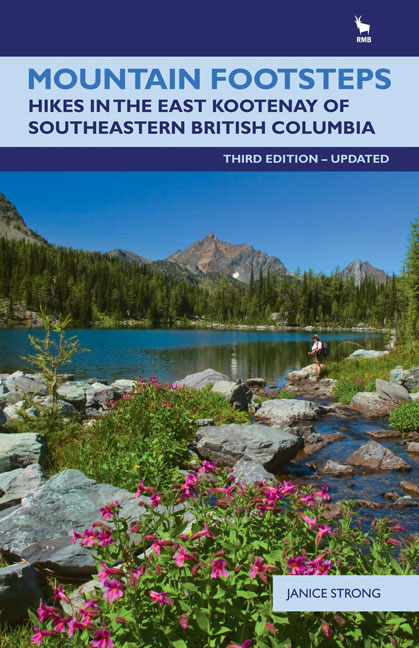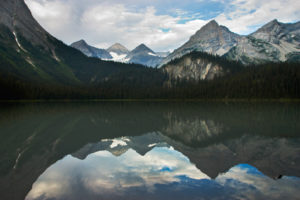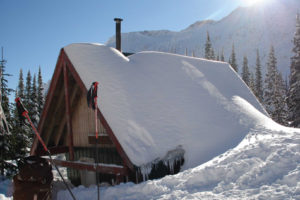Distance
The trail is a fine example of the excellent quality of early trail-building in the East Kootenay, in that much of the original grade can still be used by hikers a hundred years later. It is an evenly graded trail, with appropriate switchbacks, and the trail is carved from the hillside, making a flat tread to step on.
The first 4 km of the Sunken Creek trail is an enjoyable half-day outing where you climb steeply between two bridges crossing Sunken Creek. The turbulent creek plunges down beside the trail and water cascades over large mossy rocks. The pleasing sounds of the bubbling splashing creek and the deep dark forest, makes this a pleasant short hike.
Beyond the second bridge, the trail climbs on the sunny southern aspect and the baking, dried out hillside is very hot on a summer day. If you hike the entire length of the trail, it is a long steep excursion up the south side of a narrow gully, which gains over 1360 m (4,460 ft.) in The Steeples mountains. The trail leads to a view of what is left of the Dibble Glacier.
Further explorations
Five Passes trail
The hiking in the region of the southern Rockies is compact, with mountains joining together in hikable passes and ridges. The entire upper 5 km to Dibble Pass along the Sunken Creek trail is part of the Five Passes trails. The loop starts from Mause Creek, into Sunken Creek and heads around to Tanglefoot Lake and back to Mause Creek. entry #39.
History
About halfway between the two bridges there are the remains of an old log cabin. It is one of the oldest traces of a cabin that I have seen. Only a corner of the hand-hewn, dovetail log construction remains. A pile of rubble rock, which once served as a hearth, is tucked in the “back” of the extremely primitive cabin. A clear, natural spring still seeps out of the hillside into a ditched-out hollow behind the cabin. A midden of tin cans, with the “lead plugs” used for sealing them, gives an indication of the age of the place: 1920s or earlier. The cans were not opened with a can opener, but crudely with a square punch of some kind.
The trail was built as a mining pack trail in the 1890s for access to the Dibble Mine, which was a rich deposit of turquoise-coloured copper, silver and some gold. The pack horses hauled the ore about 18 km down this steep trail, all the way to Fort Steele. Lore about this trail mentioned that, instead of carrying the ore in packsaddles, the horses dragged the ore down the trail in rawhide bundles. They could haul more that way, but it doesn’t sound very safe, considering how steep-sided the creek gully is along this trail.
To second creek crossing
Rating: moderate
Time: half day hike
Distance: 4 km to second creek crossing
Trail: steep forested trail by pleasant creek deep valley
Elevation gain: 300 m (1,000 ft.)
Entire trail
Rating: moderate to long
Distance: about 10 km to Dibble Pass
Elevation gain: 1360 m (4,460 ft.)
Dibble Pass: 2220 m (7,270 ft.)
Maps: 82G/11 Fernie (NAD27); 82G/12 Cranbrook (NAD83)
0 km: At the first parking spot on Sunken Creek Road, N92700-E08732, at the sign for Sunken Creek BC FS with trail assistance by the Kootenay Backcountry Horsemen, at 877 m (2,880 ft.). Take two right forks in the road to the second parking spot. Hike southeast in a dry Douglas fir forest and begin the steep climb.
1.6 km: Cross the first twin-log bridge of round logs. Crossing the creek in June or high water could be intimidating. Throughout the rest of the summer and autumn, this crossing is easy. A horse crossing is just 20 m downstream. After the first crossing, keep climbing steeply on the narrow trail and within 500 m take the next two uphill left forks.
2.4 km: Come across the ruins of an ancient log cabin in a young forest, at 1150 m (3,770 ft.).
2.6 km: The second crossing is a single, large, round log with a smaller log spanning the creek for a handrail. After a pleasant morning walk many hikers turn back at this second crossing. Beyond the second crossing, the trail continues high on the south bank, well above the fast-moving creek. The trail climbs steeply up the southern slope for many more kilometres. I have not followed the whole trail, but I often enjoy the lower part of this historic Sunken Creek trail.
5 km: Approximate Junction with Six Passes Trail, N94158- E11164, at 1554 m (5,100 ft.).
7 km: Approximately the abandoned Dibble Mine site. There is likely nothing left but a clearing.
10 km: Approximately Dibble Pass, N94007-E14412, at 2220 m (7,270 ft.). This is the junction for Five Passes trails continuing north to Bear Pass. The Sunken Creek trail may still continue down the eastern side toward Dibble Creek on the Bull River, ending about 11 km.
Directions
Road: any vehicle; last 1.3 km may be rough and muddy
Sunken Creek from Wardner/Fort Steele Road. The last 1.3 km is old, non-status, unmaintained mining access road across a flat, rough and muddy field. It crosses range seeding, where the BC Forest Service manages the cattle-grazing on Crown land and this flat meadow has been seeded with range grasses for ungulates and cattle.

Janice Strong
Janice Strong is an established professional outdoor photographer. Her images grace collections all over the world and appear in many respected publications. She is passionate about hiking and is also an avid snowshoer and skier, exploring the outdoors of the East Kootenay in southeastern BC year round.She openly shares her passion for the outdoors with others and has introduced hundreds of people to the joys of hiking. For a decade she led hikes for the City of Cranbrook – Parks and Recreation. With her guidance, many people have themselves become enthusiastic hikers.
Climbing mountains, finding new places and enjoying the experience of the journey have always been important to Janice. She cherishes the little things she sees along the trail, as well as the grand destinations.
When Janice is not writing, hiking or taking photographs, she is involved in various creative digital, website design or photographic projects for her clients. She and her husband, Jamie Levine, enjoy their rural property, near Cranbrook, BC.




